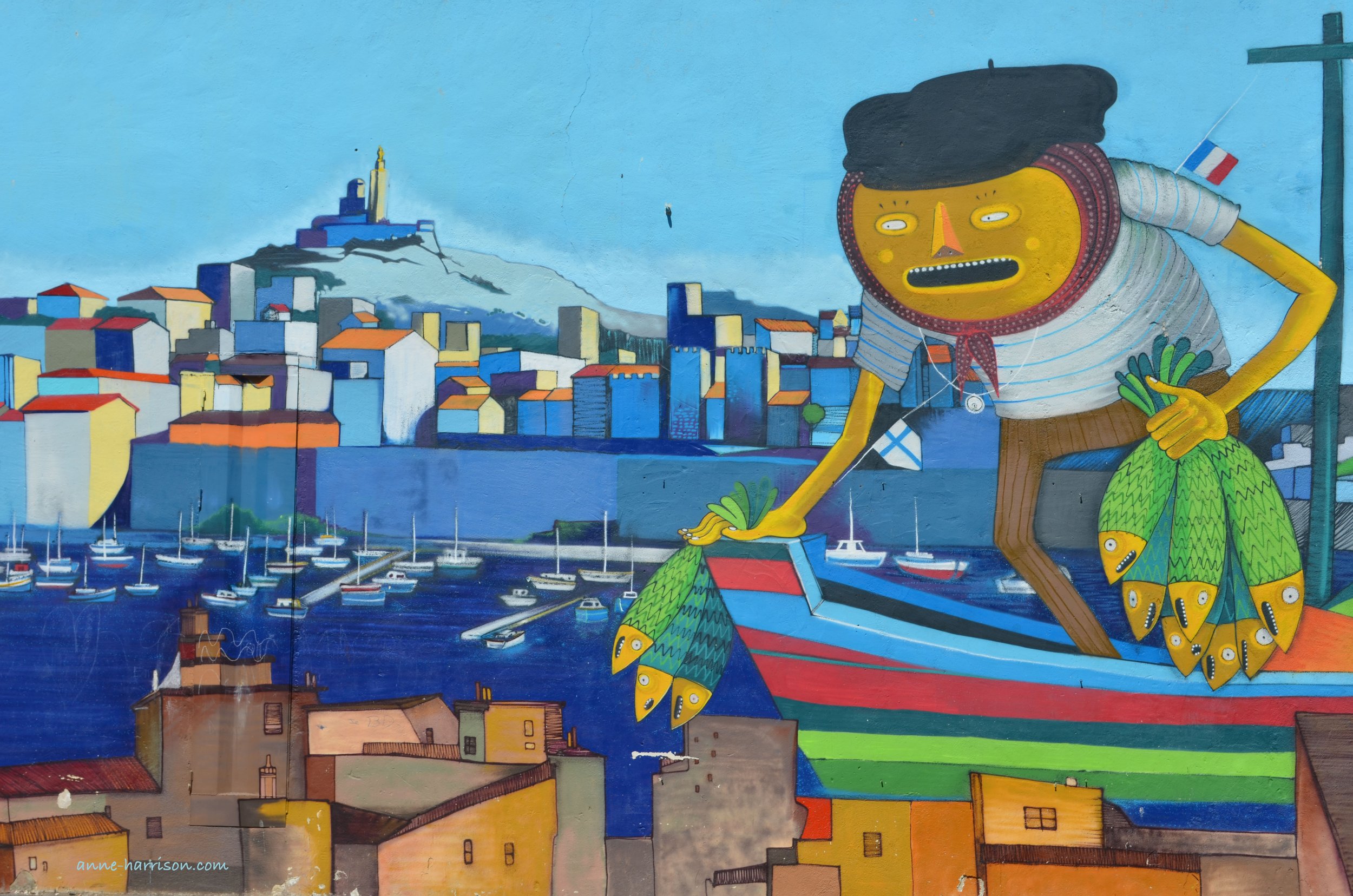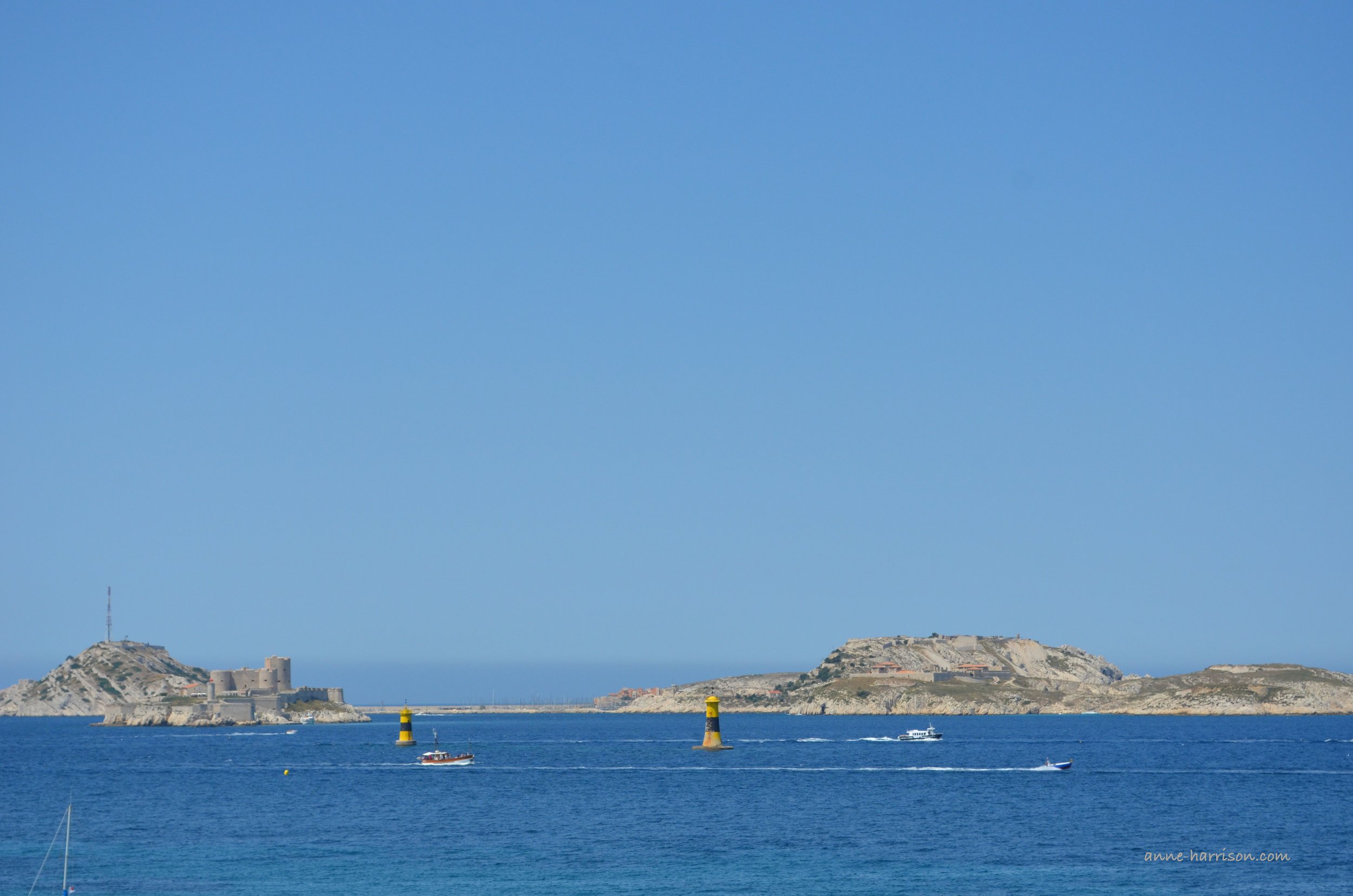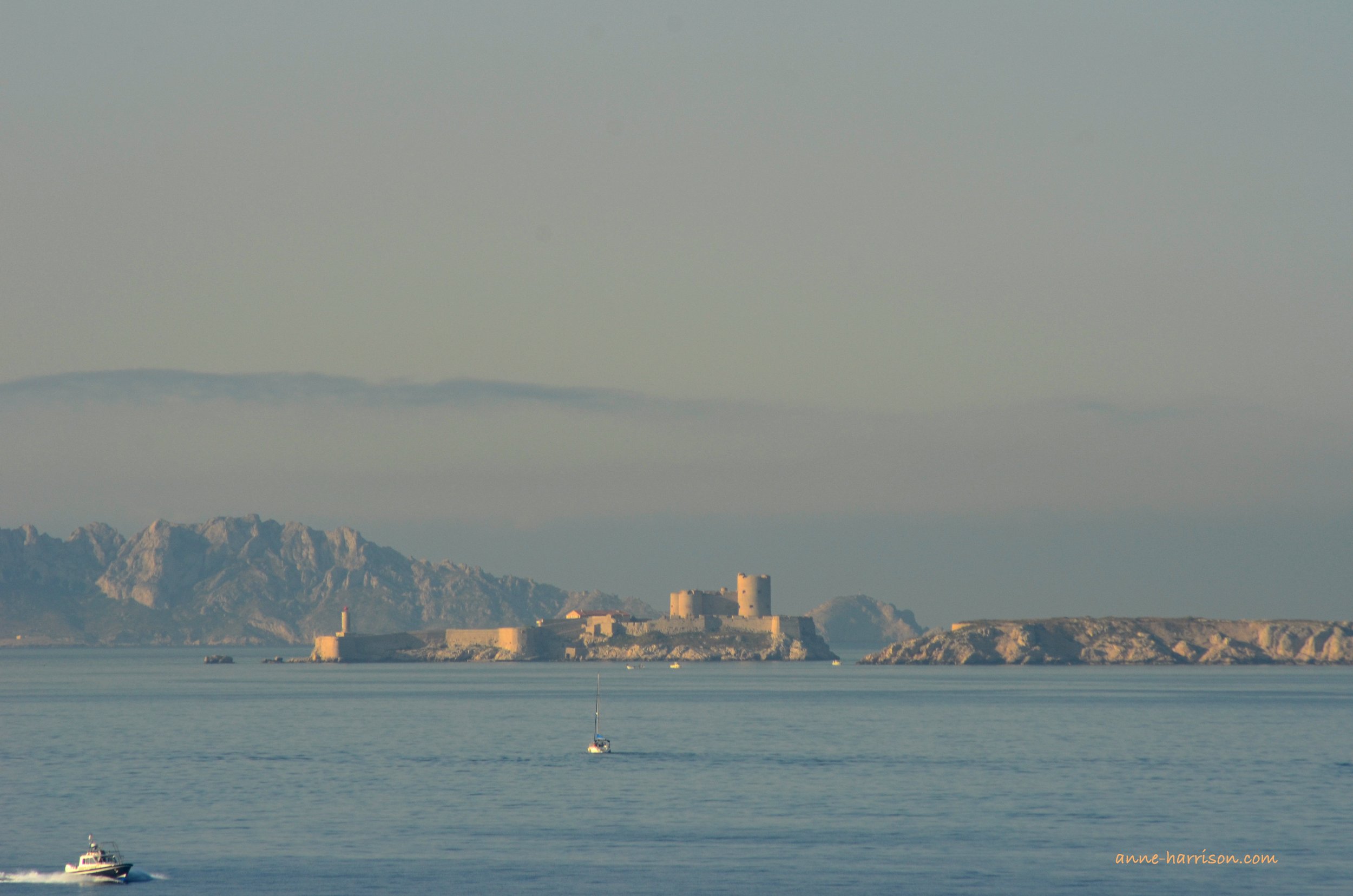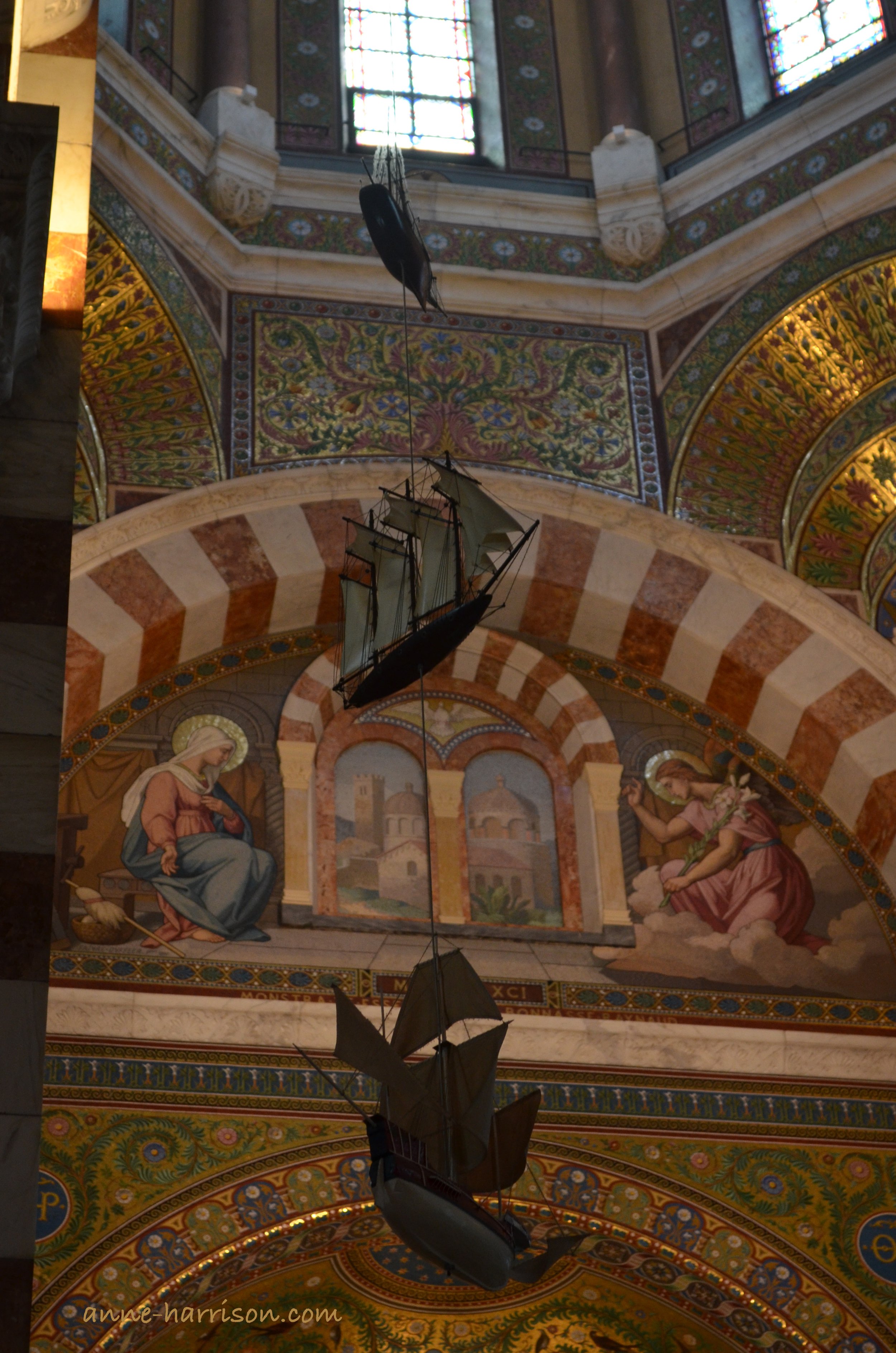A Mural in Marseille
A mural in Marseille © A. Harrison
As I wandered around the maze which is Old Marseille, an alley suddenly opened onto this stunning mural. Behind me rose the terraced labyrinth of Le Panier, rebuilt after its destruction during WWII. Almost directly below lay the harbour, the water dazzling under a summer sky. Fishing ships bobbed on the waves, finished for the day. Shouts and calls rose from the fish market, and tourists thronged along La Canebière and other streets of the town. Across the bay the madonna atop Le Notre Dame de la Garde was blinding in the sunshine, calling home all those as sea. Somewhere was a restaurant waiting to serve me the perfect bouillabaisse.
I could see all of this in the mural before me.
View across the bay to the Basilica de la Notre Dame de la Garde © A. Harrison
Towering over all in the painting is a fishermen (complete with eye-catching scarf) holding his catch. Unlike most towns dotted along the French Riviera, Marseille remains first and foremost a fishing port. She was a fishing village long before the Greeks called her Massilia in the 7th C BCE. The working boats in Marseille far outnumber the luxury yachts.
The fisherman holds a variety of rather startled fish. A fish market is still held daily on the edge of the Vieux Port, where the offerings of the Mediterranean are on display. Traditionally, fishwives would make a rich broth from all manner of fish, muscles, scallops — whatever hadn’t been sold from the day’s catch - and from this arose the famous bouillabaisse.
Although there are as many recipes for bouillabaisse as there are cook books, it is the small and bony fish which give the soup its flavour — as does the rich capsicum-garlic roulade.
A true bouillabaisse takes as least 20 minutes to prepare. I filled in the time sipping on a glass (or two) of a local rosé. Highly recommended.
One of the wider streets in Le Panier © A. Harrison
In the foreground of the mural lies the maze of Le Panier. Towering directly above the Vieux Port, it can be reached by a ridiculous number of very steep stairs. In the midst of a Mediterranean summer, when the heat radiates from the footpath and stone walls, I chose instead to catch Les Petits Trains.
Totally touristy, these little carriages tootle along alleyways an over-sized sight-seeing bus can only dream of. With a canopy against the sun and open sides to catch a breeze, they are great way to get around the city when time is short and the days hot.
Once the site of the Ancient Greek marketplace, then home to fishermen and merchants, Le Panier grew to a rabbit warren only a local could navigate. As the Germans found in WWII, Le Panier was also impossible to police. In the depths of winter in 1943, over 20000 people were given a day to evacuate, before the place was razed to the ground.
Since the end of WWII Le Panier has been rebuilt, and some of the original streets remain. Nothing seems to run in a straight line, and with many laneways connected by stairs, as I wandered I often turned into an unexpected courtyard, or suddenly caught a glimpse of the harbour far below. Washing was strung above me between the houses, but in the next street I’d find some artisan shops and an entrancing cafe. I wish I could have spent days here, though with all probability I would never find my hotel once I ventured forth.
The Ancienne Cathedral de la Major © A. Harrison
On a hill in the background of the mural stands the Basilica de la Notre Dame de la Garde. The church dominates Marseille. Earlier this morning I had spied her golden madonna while still far out to sea. (Interestingly, the Chateau D’If is impressively close to shore. Not the impression Dumas gives in the Count of Monte Christo.)
To reach the basilica necessitates a trip through the more touristy area of Marseille. Travellers (and sailors) from all over the world congregate here. These buildings can also be seen in the mural, lining Le Canbière, known to many an American troop as The Can Of Beer.
As can be seen in the mural, the buildings around here are reminiscent of Paris. Louis XIV designed Le Canbière as a major thoroughfare, and it is lined with buildings in the same style and stonework, even the same wrought-iron balconies as Paris. Despite this pedigree, Le Canbière has often been called the seediest street in France.
Le Chateau D’if © A. Harrison
The approach to the Basilica de la Notre Dame de la Garde is via hair-pin turns reminiscent of Monaco’s Corniche, which become ever steeper. The final stretch was filled with olive and oleander trees, and the sound of cicadas.
The basilica is a Byzantine masterpiece filled with mosaics which leave the air glistening. Votive offerings of model boats hang everywhere, as well as painting and pictures of vessels, have been donated by grateful sailors and their families. The basilica was almost empty, and incredibly peaceful. Below is a museum filled with Roman frescoes, missed by many who visit.
For me, Marseilles was a wonderful discovery — and her whole spirit was captured in a mural on one of her oldest streets. Who needs a map when you can have a painting?
Views of Basilica de la Notre Dame de la Garde © A. Harrison
Like my photos? - if you feel like contributing to my coffers, please click either here or on the link in my header to buy (or simply browse) my photos. Or else, please click here to buy either my poetry or novel ebooks. I even have a YouTube channel. Thank you!
Need something to read while travelling? May I suggest my second novel:
The Footstep Thief
A murder mystery with no murder, The Footstep Thief takes place in a Kafkaesque world where Stephanie enters a maze of night shifts in a university laboratory in an Australian country town. When time allows Stephanie passes her nights hunting down the perfect vending machine, searching for the Grey Nurse, imagining herself in classic movies, and talking to her dead brother, Dave.
Yet over the course of one week Stephanie's world untangles. Struggling to find a hidden meaning in Dave’s cryptic last message, she has to cope with the likes of her ex-lover, Jason (now a fledgling celebrity) who reappears to prepare a television show; or Gillian, Dave’s would-be fiancé, who places a controlling finger everywhere. Even Stephanie’s flat-mate keeps a list of her failings against God on his clipboard.
Then one night Stephanie sights Dave’s nemesis, Sir Dom.
The Footstep Thief was originally published as a short story (Ariadne’s Thread) in the 2010 Sleepers Almanac (reviewed in the Sydney Morning Herald as grim but vivid – Kerry Goldsworth)










